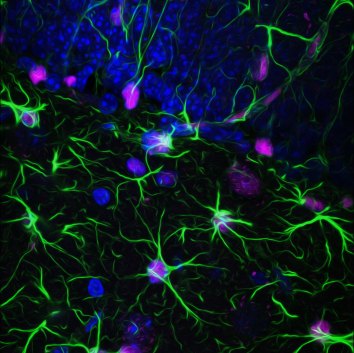
Snapshots of Life: The Birth of New Neurons
After a challenging day at work or school, sometimes it may seem like you are down to your last brain cell. But have no fear—in actuality, the brains of humans and other mammals have the potential to produce new neurons throughout life. This remarkable ability is due to a specific type of cell—adult neural stem cells—so beautifully highlighted in this award-winning micrograph.
Here you see the nuclei (purple) and arm-like extensions (green) of neural stem cells, along with nuclei of other cells (blue), in brain tissue from a mature mouse. The sample was taken from the subgranular zone of the hippocampus, a region of the brain associated with learning and memory. This zone is also one of the few areas in the adult brain where stem cells are known to reside.
Kira Mosher, a postdoctoral fellow in the NIH-supported lab of Dave Schaffer at the University of California, Berkeley, captured this striking image using a confocal microscope. Then, to make it really pop, Mosher used photo-editing software to add a few “oil painting” effects. For her efforts, the micrograph was named a winner in the UC Berkeley 2017 MIC Image Contest.
Images like this one are helping the Schaffer lab pinpoint the locations of neural stem cells and map their interactions with other cells, providing clues to their potential roles in health and disease.The researchers also plan to use CRISPR gene-editing tools to tinker with neural stem cells and learn more about the molecular signals needed for them to function normally.
As scientists gain a more detailed view, the hope is they’ll be in a better position to figure out how to transplant or activate neural stem cells for possible use in brain repair. Such research might lead to new strategies for helping people with stroke, Alzheimer’s disease, Parkinson’s disease, and other conditions in which neurons are lost.
Links:
Focus on Stem Cell Research (National Institute of Neurological Disorders and Stroke/NIH)
Schaffer Lab (University of California, Berkeley)
NIH Support: National Eye Institute; National Institute of General Medical Sciences; National Institute of Neurological Disorders and Stroke























.png)











No hay comentarios:
Publicar un comentario